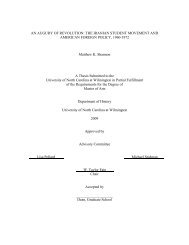Saprolegnia - The iLumina Digital Library
Saprolegnia - The iLumina Digital Library
Saprolegnia - The iLumina Digital Library
You also want an ePaper? Increase the reach of your titles
YUMPU automatically turns print PDFs into web optimized ePapers that Google loves.
originally thought it to be. Accordingly, the names Pythiopsis intermedia and Isoachlya<br />
intermedia are not considered to be synonymous (Seymour, loc. cit.) with <strong>Saprolegnia</strong><br />
itoana.<br />
<strong>The</strong> <strong>Saprolegnia</strong> sp. No. 28 described by Kobayasi and Konno (1971a) appears to<br />
have some affinities with S. itoana in general configuration of the oogonia. As their<br />
species had catenulate oogonia and seldom formed antheridial branches, it cannot be<br />
equated confidently with S. itoana. Kobayasi and Konno, moreover, did not describe<br />
the oospore type of their isolate. We are listing their fungus among the unidentified<br />
members of the genus.<br />
In their study of DNA base compositions, B. R. Green and Dick (1973) stated that<br />
the GC values obtained by them supported Seymour’s (loc. cit.) removal of Isoachlya<br />
subterranea to <strong>Saprolegnia</strong>.<br />
CONFIRMED RECORDS: -- BRITISH ISLES: O’Sullivan (1965:233, 272, figs. I-4-6,<br />
I-13, I-14, II-1-19, II-21-34). GERMANY: Dissmann (loc. cit.); Richter (loc. cit.). JAPAN: S.<br />
Ito (1936:73, fig. 31); Nagai (loc. cit.). REPUBLIC OF CHINA: Chiou et al. (1975:165, pl. 2,<br />
fig. 19). UNITED STATES: R. L. Butler (1975: figs. 13-16); Fox and Wolf (1977:102, fig. 6);<br />
T.W. Johnson and Surratt (1955:124, figs. 1-13, 15, 17-21, 23, 25-34); Kelman (1947:210, pl.<br />
27); Seymour (loc. cit.); A. W. Ziegler (1948b:20).<br />
RECORDED COLLECTIONS: -- BRITISH ISLES: Dick (1964, 1966); Pickering and<br />
Willoughby (1977). JAPAN: S. Ito and Nagai (1931); Suzuki (1961f). UNITED STATES:<br />
T. W. Johnson (1956a).<br />
SPECIMENS EXAMINED: -- UNITED STATES (14) RLS. Centraalbureau (1);<br />
MWD (2).<br />
<strong>Saprolegnia</strong> anisospora deBary<br />
Bot. Zeitung (Berlin) 46:619, pl. 9, fig. 4. 1888<br />
(Figure 101 D-G)<br />
Isoachlya anisospora (de Bary) Coker and Matthews, North Amer. Fl. 2(1):26. 1937.<br />
Monoecious. Sporangia cylindrical, clavate, or fusiform, but usually curved or<br />
irregular in general configuration; renewed internally or by cymose branching or<br />
basipetalous succession; 60-227 x 16-37 µm. Spores dimorphic or rarely monomorphic;<br />
discharge and behavior saprolegnoid, rarely dictyucoid; primary spores commonly of<br />
three size groups: 25-33 x 10-12 µm, 20-24 x 10-13 µm, or 11-14 x 8-11 µm, such groups<br />
are usually in separate sporangia rather than being intermixed in the sporangium.<br />
Oogonia lateral, terminal, or intercalary; spherical, obpyriform, or dolioform,<br />
occasionally napiform; (36-) 40-60 (-93) µm in diameter. Oogonial wall pitted under<br />
region of attachment of antheridial cells, very infrequently elsewhere; smooth. Oogonial<br />
stalks ( 1 / 4 -) 1 / 2 (-3) times the diameter of the oogonium, in length; stout, straight or<br />
curved, unbranched or once-branched. Oospores eccentric, but sometimes aborting;<br />
spherical, usually nearly filling the oogonium; wall thin or thickened; (1-) 4-6 (-l8) per<br />
642
















